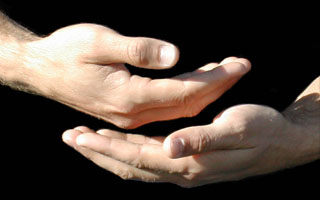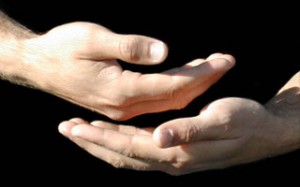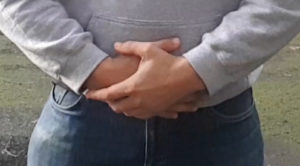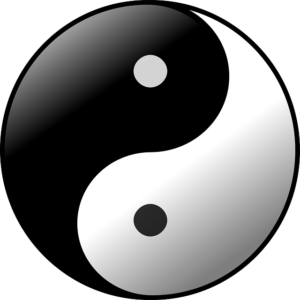
Which hand should go on top of the other when placing them on your dantien is a question that comes up again and again from qigong students. Sometimes it comes from new students who are just curious, and other times it comes from moderately experienced students who are confused by what they have been taught by other teachers. This is one of those little pieces of qigong theory practice that has often been passed on as something you should just do ‘because’ rather than with a clear understanding of the theory and physiology behind it.
This article will give you a comprehensive answer to this question that will help you to understand the effect of placing your hands on your dantien in different ways, so that you can choose for yourself which is best for you in your practice, and hopefully encourage you to think a little bit deeper about other aspects of your practice as well to understand them better. There are reasons for each of those little details contained in the practices. It is fine to just follow along and do what your teacher has told you to do, but as you develop in your practice, understanding these details will make your practice richer and more effective. If there are aspects of your practice that you do not understand – perhaps you can ask?
Why do we put our hands on the dantien?
There are two main purposes of for placing your hands on your dantien. One is to activate and balance the energy, or qi, there, the other is to settle and store energy that may have been stimulated and circulated from other parts of your practice. While you may place your hands on your dantien at any time during a practice, there are four main times this is likely to occur:
- At the beginning of practice, to wake up the energy and prepare it so that it can be circulated through your body. This is often accompanied by massaging movements.
- Part way through a practice, it is common to gather the energy to your center before you send it out again as you transition from one phase of working with your energy to another. This usually takes the form of just a brief pause.
- At the end of your practice to settle your energy and store it within so that the energy stimulated by your practice is not dissipated and lost. This can be long or short.
- In practices where you are specifically focusing on activating or balancing the dantien. This may form a large part of the practice and may go along with other movements of the body, particular types of breathing, visualization, and so on.

What is the effect of placing the hands?
There are three main effects of placing the hands, whether that be on the dantien or some other part of the body.
- Physical stimulation. This is more obvious in practices that involve massaging or patting where the stimulation is more vigorous, but even just placing the hands gently on the surface of your body creates a physical pressure that your body naturally responds to, activating the energy.
- The touch of your hands also naturally brings your attention and awareness to wherever they touch. Neural pathways open. Circulation and nerve activity increases, directing energy to the area.
- Energy transmission. Finally, we naturally have strong energy flow to our hands. We use our hands for fine motor skills to interact with the world. This means we have strong neural pathways, rich blood supply, and a natural habit of sending energy from our hands out into the world around us. This energy that flows easily to the hands then projects into wherever they touch.
These three factors combined, make touch with the hands a very effective way to bring energy and awareness to an area.

Why does it make a difference whether you put the left or right hand on top of the dantien in qigong? (Its all about Yin and Yang)
This has to do with the quality of the energy from each hand. The energy of the left hand is more yin, and the energy of the right hand is more yang.
There are many reasons for this relationship between the left and yin, and the right and yang in the body. One of these is that the right side of the body is controlled by the left side of the brain. The left side of the brain is responsible for more structured and logical thought – a yang characteristic, while the right side of the brain is responsible for more flowing and intuitive thought – a yin characteristic.
This is why up to 95% of the population are righthanded. It makes sense to use the left brain to direct the right hand activity when focusing on active and finely detailed work. This does not mean that the left hand is not doing anything during an activity, but rather that it has a different role. It will often be supporting and steadying (a yin characteristic) while the right hand is being more yang and detailed. Each of these roles is equally important – they are just different. Another good example of this occurs in the legs. If you kick with the right foot – while the right leg develops finer motor control, the left leg usually develops more strength, as it needs to stabilize and support while the fine motor control takes place.
Yin cannot function without yang, and yang cannot function without yin, but this does lead to differences in development and the qualities of energy flow. The energy of the left hand has all of the yin qualities: solid, heavy, calming, cooler, while the energy of the right hand has all of the yang qualities: empty, light, activating, warmer.

Placing the left hand on the dantien with the right hand on top of it will tend to strengthen the yin aspect of the energy in the dantien – yin supported by yang. Placing the right hand on the dantien with the left hand on top of it will tend to strengthen the yang aspect of the energy in the dantien – yang supported by yin.
Which one is better for you?
There are several different opinions on this which I will present to you here, and also give you some guidelines for how you can choose for yourself whether it is better for you to place your left or right hand on top of your dantien when you are doing qigong.
One of the main criteria often used to decide whether you should put your left or your right hand on your dantien in your qigong practice is what gender you are. According to yin yang theory, males are categorized as yang, and females are categorized as yin. (I won’t go into detail here about why this is the case, yin yang theory is simple in many respects, but has so many details in application that it can take quite a bit to explain specific aspects of it which might be a bit too much of a digression from our current topic, but look out for further information about yin and yang theory both in blog articles and course material at Long White Cloud Qigong in the future.) So… if a male wants to strengthen his innate yang character, he would place his right hand in contact with his dantien with his left hand on top. A female would do the reverse, and put her left hand in contact with her dantien and her right hand on top. On the other hand, some teachers instead teach that males should place their left hand in contact with their dantien and their right hand on top so that the yin stimulation of their hands will balance the innate yang qualities of their energy, and vice versa for females…
So which one do you choose? Well it may help to recognize that not all males and all females are the same, and you may have either intrinsic aspects of your nature, or more transitory things going on with your energy that may make one or the other better for you specifically. For example, you may be a very yin female, who needs yang stimulation to keep your yin in balance. Similarly, you may be a female who for whatever reason, be it nature or nurture, has inherently strong yang already, in which case you may benefit more from yin stimulation to support your female yin character. In the case of health, if you have overactive energy, perhaps due to an infection of some kind, regardless of your gender you may benefit more from yin stimulation. On the other hand if perhaps you have weak digestion, or your energy is otherwise low in activity, you may benefit from more yang stimulation.
Early in your practice, following broad general advice will usually be fine, but as you progress you will want to be able to tailor your practice more specifically to your own needs. As you become more experienced working with energy, you will be able to feel the difference in stimulation of the energy caused by putting one hand above the other. You can then try each way of placing them, and see which one feels best to you at the time, which one feels like it nurtures and supports your energy most effectively. Most of the time you will probably have a habit of doing it one way, but developing your own awareness of its affect on your energy will allow you to adapt and change according to your specific needs as there are changes in your life and different circumstances to be addressed. And of course when health issues arise you will be able to consciously choose which will be best for your situation, or be able to better understand and follow the recommendations of a medical qigong/qigong healing practitioner who may assist you in directing your energy in a way that will be beneficial to you.
Conclusion
Qigong is filled with such small details that contribute to the overall effect and benefits of your practice. While you need not be too concerned about getting all of these details ‘right’ or ‘wrong’ early in you practice, understanding them on both a theoretical and experiential basis will greatly enrich your practice.
I hope that you have enjoyed this exploration of if it is better to put your right or left hand on top of your dantien in your qigong practice. If you are still not clear on some of the details of how this works, you might find it useful to also watch the vlog video that I recorded about this topic below:
You may also like to subscribe to our email newsletter below so that you can stay informed about future articles and also courses, retreats, and other events from Long White Cloud Qigong.
Yours in qi!
John Munro
Founder – Long White Cloud Qigong